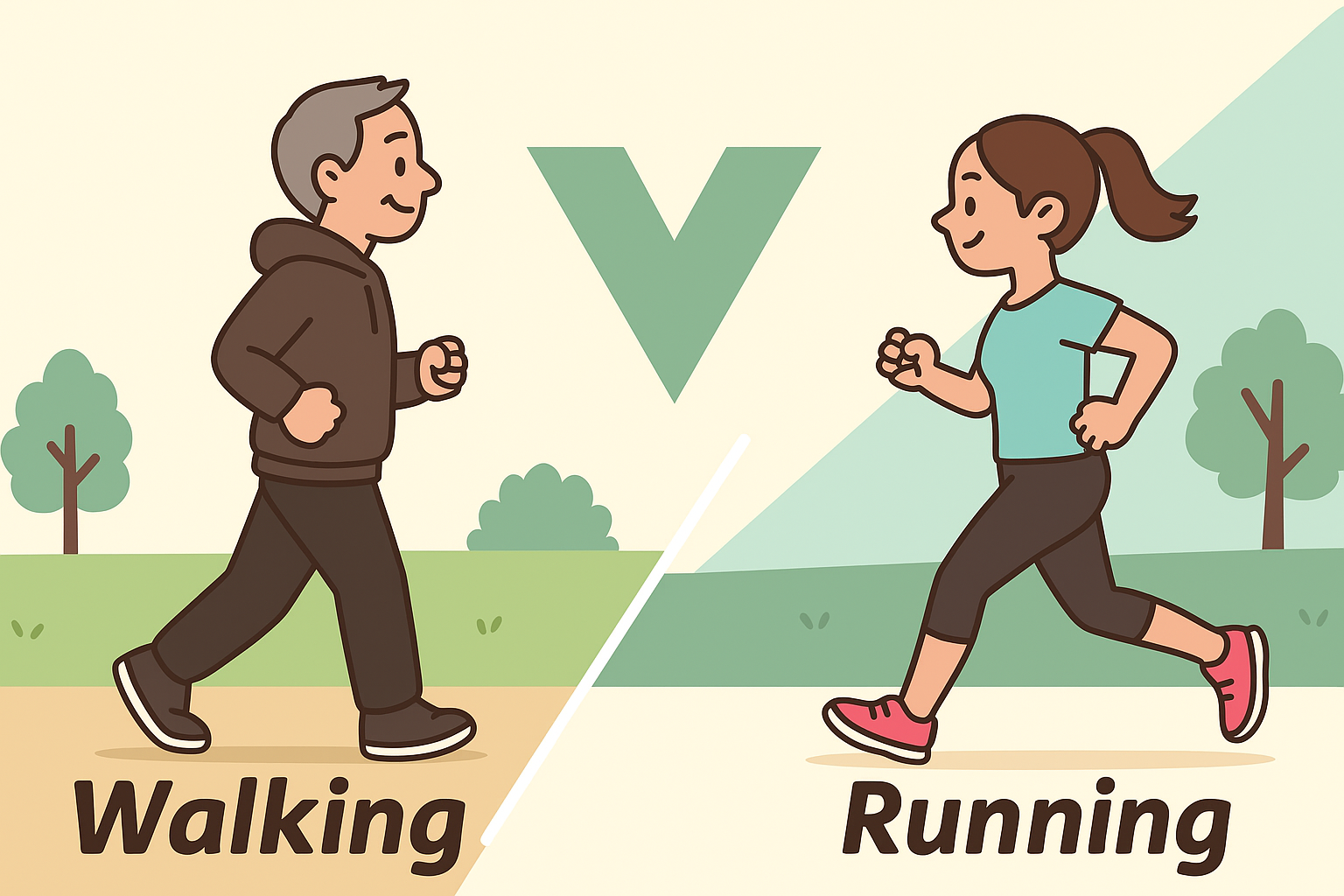Jogging vs Walking: Which Cardio Is Better for You?
 When it comes to aerobic exercise, few debates are more common than “Should I walk or should I jog?” Both have strengths, and which one is “better” depends largely on your goals, health, and preferences. In this article, we’ll break down what research says about walking versus jogging, help you decide which might suit you best, and offer tips for making either work.
When it comes to aerobic exercise, few debates are more common than “Should I walk or should I jog?” Both have strengths, and which one is “better” depends largely on your goals, health, and preferences. In this article, we’ll break down what research says about walking versus jogging, help you decide which might suit you best, and offer tips for making either work.
What Walking and Jogging Have in Common
Walking and jogging are both forms of cardio — aerobic activity that gets your heart pumping, your lungs working, and your metabolism revving. Each supports improved cardiovascular health, helps with weight management, strengthens the muscles (especially in your lower body), and can boost mood, lower stress, and support longevity.
Because both use large muscle groups in a rhythmic, sustained way, even walking provides many of the benefits associated with more intense cardio.
Jogging’s Edge: Efficiency & Intensity
If your primary goal is to burn calories, improve cardiovascular fitness faster, or do more in less time, jogging tends to offer advantages:
- Higher calorie burn per minute. Studies suggest that jogging burns roughly double the calories per minute compared to walking (for a given person).
- Greater cardiovascular stimulus. Jogging challenges your heart and lungs harder, helping raise VO₂ max (your body’s ability to use oxygen).
- Risk/benefit trade-off. The higher intensity means more strain on joints, bones, and muscles, increasing the risk of overuse injuries if you ramp up too quickly.
- Stronger bone and muscle adaptation. Because jogging is weight-bearing and more forceful, it tends to lead to greater stimulus for bones and muscle development.
So if you are healthy, have good joint resilience, and want faster results, jogging is often the stronger option — as long as it’s done smartly.
Walking’s Strengths: Accessibility, Lower Risk, Consistency
Walking shines in its own right, especially under the following conditions:
- Low impact, safer for joints. Walking puts less stress on knees, ankles, hips, and connective tissues, making it a better option for beginners, older adults, or those recovering from injury.
- High sustainability. Because walking is easier to maintain day after day, it tends to support consistency and habit building.
- Good health effects even at moderate pace. Walking briskly or in intervals still provides benefits for blood sugar, cholesterol, and cardiovascular risk.
- Gentle entry point. For those just starting out or returning to exercise, walking is an excellent stepping stone to more vigorous forms.
In many cases, people get stuck comparing walking and jogging abstractly, while the real key is consistency. A long, brisk walk six days a week might outperform a short jog that you can’t sustain.
What Science Tells Us: Risks, Benefits, and Health Impact
- A cohort study found that compared to walkers, runners had significantly lower risks of hypertension, high cholesterol, and type 2 diabetes.
- But even walking alone—without jogging—has been shown to reduce risk of chronic disease and improve markers like blood sugar and cholesterol.
- Overuse injuries are a concern for runners; studies report that a large share of runners experience injuries that sideline them for a time.
- The key differentiator is often time, intensity, and how your body tolerates stress.
Which Should You Choose?
Here’s a simple guide or decision framework:
| Your Situation | Better Option | Why |
|---|---|---|
| You want to lose weight faster, improve fitness quickly, and your body is healthy | Jogging (or interval jogging) | You burn more calories per minute and push your cardiovascular system harder |
| You have joint issues, are older, recovering, or a beginner | Walking | Less stress, more sustainable, still beneficial |
| You have limited time | Jogging (shorter sessions) | More “bang for the buck” |
| You prefer low risk, more consistency | Walking | Easier to stay active daily |
| You want to build up over time | Start walking, then transition to jogging | A progressive approach minimizes injury |
Also consider hybrid approaches: walk-run intervals, walking hills, power walking, or alternating days of walking and jogging can let you get benefits of both without overdoing one side.
Tips to Make Either Work Better
- Gradually increase your duration and intensity. Don’t leap into long jogs if your body isn’t ready.
- Use proper footwear with support and cushioning.
- Warm up and cool down with dynamic and static stretches.
- Incorporate rest days, cross-training, and strength work to balance and prevent injury.
- Listen to your body — pain, persistent soreness, or joint strain are signs you may be pushing too hard.
- Track your progress (distance, speed, heart rate) and adjust.
